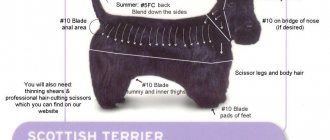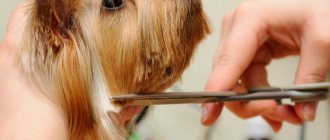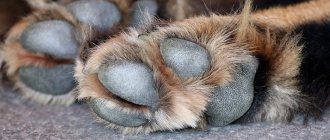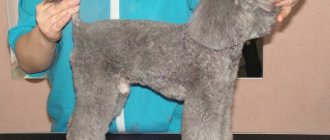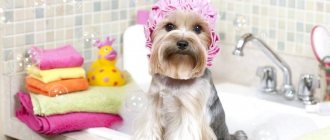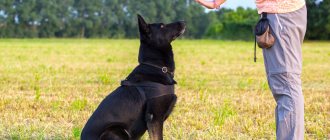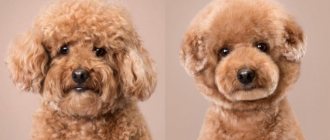Every owner wants to see their pet healthy and beautiful. But feeding, walking and playing with your dog properly is not enough; you also need to pay attention to its appearance. An essential part of caring for an animal's appearance is grooming. Some owners prefer to entrust this procedure to specialists and take their dogs to grooming salons. From the article you will learn how to cut your pet’s hair with scissors and clippers yourself, as well as how to choose the right cutting tools.
Haircutting tools
To groom your dog yourself, you must have the following tools:
- tangle cutter;
- comb;
- electric machine;
- scissors.
If you have trimmed your dog in a grooming salon, and the pet tolerates the procedure well, then it makes sense to buy an expensive professional clipper. But if you are going to carry out the procedure for the first time and do not yet know the dog’s reaction, then it is better to choose an economy class electric or mechanical type machine for the first time.
Mechanical clippers are used to trim the hair on an animal’s paws or face. They are activated by mechanical movement of the hand. Since the power is minimal, cutting an entire dog with such a clipper is quite a tedious task, but it is great for trimming some small areas.
Electric machines are divided into two types:
- Rotary machines are a universal type of machine with high power. Cuts any type of coat - from soft and silky to stubborn and tough. A big plus is the silent operation of the machine, which is why the dog behaves calmly during the haircut, without being distracted by extraneous noise. The advantages also include removable knives and a cooling system. There is only one drawback - the price;
- vibrating – used for grooming small breeds of dogs. During operation they vibrate and make unpleasant noise. Despite their low power, such machines are quite popular due to their low price.
The choice of scissors, combs and tangle cutters will depend on your dog's coat. In a pet store you can easily choose the appropriate option, and sales consultants will help with this.
In addition to tools for trimming hair, you need to purchase a rectangular mat with an anti-slip rubberized base on which the dog will stand during the procedure.
Why is this necessary?
In non-shedding and soft-haired breeds, the fur grows throughout its life (like human hair). If it is not cut, the pet will no longer look attractive and will acquire a whole range of problems: tangles, dermatitis resulting from them, scratching, wounds, secondary infections of the skin, parasites. The hair growing in the ears will develop pathogenic microorganisms that cause inflammation and ear disease.
The fur around the eyes and the beard of some breeds should be hygienically trimmed at least once every 2-4 weeks. The paws are also trimmed between the toes, as dirt and debris stuck to it cause discomfort and sometimes pain to the dog. Biological contaminants accumulate around the anus, especially in long-haired dogs, which can smell bad, spoil the dog’s appearance, and cause irritation or inflammation.
Any owner can trim, shorten, and give a hygienic haircut at home. But it is better to entrust exhibition grooming to professionals, at least at first.
Types of haircuts for dogs
Conventionally, all haircuts can be divided into two large groups:
- Hygienic – carried out for various breeds. The group includes: - removal of hair between the pads on the paws, on the muzzle, in the ear area and genitals; - cutting out tangled pieces of wool; - haircut for certain indications (fleas, dermatitis, numerous mats). Some dog breeds, such as huskies, spitz dogs, shepherds, chow chows, shelties and Samoyeds, do not receive a complete hygienic haircut. That is, a significant shortening of the coat is generally unacceptable for them, since the thermoregulatory layer is disrupted, as a result of which the dog can freeze in winter and overheat in summer from the hot heat. In dogs with a thick undercoat, after a shortened haircut, serious problems may begin, such as hair loss and slow growth of hair. Dogs without undercoat are given a hygienic haircut more often (once a month) not only on the paws, face and ears, but also throughout the body to avoid formation hair tangling In the spring, to protect your dog from ticks, it is advisable to shorten the hair on the paws and belly.
- Modeling - includes a set of sequential operations: - cutting certain parts of the body bald; - styling the hairstyle appropriate to the type of breed; — alignment along the length of the flowing wool; — thinning and thinning the coat along the entire length. It is better to carry out a model haircut for show dogs in a special salon. But monthly visits to a specialist are quite expensive. If desired, the owner can take a basic grooming course and trim his pet himself.
How to cut a dog's hair at home
Before grooming, your pet should be bathed, dried afterwards, and then combed. For dogs with long, thick hair, especially if it is already quite tangled and matted, it is recommended to brush it before bathing. If tangles form, try to untangle them with your fingers, but particularly densely matted hair will have to be removed using a tangle cutter. When separating or cutting off a tangle, try to hold the skin around it with your fingers so that it does not pull back - this will save the animal from pain.
If you are performing a classic hygienic haircut, after bathing and drying your pet, proceed to the next procedure - cutting off the overgrown hair in the groin area, anus, at the base of the tail and, if necessary, the armpits of the animal. Please note that the genital area is a problem area on the dog’s body, and it must be treated with special care and attention. The procedure can be performed using a clipper using medium-sized attachments, or special scissors, which will provide a more delicate treatment. To avoid injury, hold your dog's genitals with your hand.
Next, start trimming the fur between the paw pads. This procedure is carried out using a machine (the nozzle must have a thin grip) or scissors. In the same way, remove the overgrown hair on the face.
Grooming animals with fast-growing hair, such as spaniels, poodles and terriers, includes additional steps: cutting the hair with a clipper on the stomach, neck, upper part of the body and on its sides, thinning, trimming the hair. After processing the body, the hair on the dog’s limbs, tail, muzzle and ears is cut or trimmed. All these manipulations are carried out in accordance with the standard of a particular breed.
The haircut is completed by trimming the claws. This procedure is carried out using special nail clippers and requires increased attention, since the dead part of the claw is closely adjacent to the part where the blood vessels are located.
Preparing your dog for a haircut
You can’t just pick up the clipper, put the animal in the bath and start trimming. Before the procedure, you need to prepare your pet. Conventionally, preparing a dog for a haircut can be divided into three stages:
- Gradually accustoming the animal to the machine and scissors. Few of our four-legged friends react normally to a haircut. Therefore, it is necessary to accustom the dog gradually, for example, when the command “sit” is given, turn on the machine for a while. For a well executed command, reward the dog. The same goes for scissors: while the dog is sitting, carefully touch the fur with the scissors. There is no need to trim anything, just accustom the dog to the tool and the clipper, be sure to praise the pet for its calm attitude and give it a treat. When the dog gets used to the grooming tools and stops flinching from being touched, move on to a full haircut.
- Tool preparation, i.e. special devices that will be required for cutting: metal scissors with rounded tips, a special clipper, a welt cutter.
- Treatment of the pet, i.e. combing and removing tangles, washing with special dog shampoo and conditioner. Washing products help make the coat smoother and more manageable, which greatly simplifies the cutting process. After washing, dry the coat and comb your pet again.
When treating your dog, don't forget to reward him with treats. Then a calm and confident dog will not break out when being groomed.
Useful tips
You shouldn’t cut your dog’s hair too short, as the fur serves not only an aesthetic function, but also a protective one. Without the required length of hair, the animal may freeze or overheat. Insufficiently protected skin is susceptible to injury, parasite bites, scratching, and inflammation.
If you doubt your abilities or your pet is a show-class dog taking part in exhibitions, attend several master classes where they will tell you and clearly show you how to cut a dog’s hair at home. Thus, by avoiding unnecessary stress for the animal, you can save considerable amounts on show grooming. Regular grooming and a good haircut will help maintain a beautiful, healthy coat and excellent appearance for your pet.
When are grooming services relevant?
Caring for an animal is an expression of love for your pet. You need to use the service for several reasons:
- unconditional love for an animal. Mats, overgrown hair, growths between the toes - all this prevents the dog from living a normal life. Classic salon care will help relieve your pet from discomfort;
- participation in competitions and exhibitions. An animal that regularly participates in competitions undergoes mandatory training. Professional grooming is carried out in accordance with established requirements;
- desire to decorate a pet. A haircut is a task of a certain style. Neat fur and shiny hair are the calling card of the animal. And the use of additional decorative elements will help emphasize the natural beauty of the pet.
In the Laicats salon, dog grooming is done inexpensively, taking into account the characteristics of the breed, as well as the client’s main request.
What will you need?
If you decide to cut your dog’s hair at home, then you can’t do without special tools:
- medium-sized hairdressing scissors;
- special comb for cutting;
- slicker;
- brushes and combs for dogs;
- trimmer or special machine;
- standard height table;
- a rubber mat or thick fabric for the dog’s comfort;
- good lighting.
What to do if the dog is naughty?
Working with aggressive, nervous and cowardly animals requires patience and endurance.
The owner himself can teach him to obediently tolerate manipulations with fur; to do this, he needs to remember the advice of breeders:
- Get used to all movements and sounds from the first months of life.
- Do not take long breaks in grooming so that the dog does not get used to the sensations.
- If the animal refuses to bear it calmly, breaks out, shows aggression or cowardice, interrupt the process and try again in a week.
- A nervous dog can be gradually trained to develop a positive reaction to hair manipulation. To do this, pretend every day that you are working with her fur coat. Turn on the machine and hair dryer, touch the fur. At the same time, speak to the animal in a calm, even voice, do not shout or use physical force. After the session, be sure to feed him something tasty and praise him. Gradually increase the time from a few minutes.
Gradually, the pet will get used to what is happening and will stop showing aggression when trying to shorten its hair. If this does not occur fully and the development of positive reactions does not help, you can try giving your pet a mild sedative before starting the procedure.
To cut or not to cut your dog?
Some dog owners who have never had their dogs cut are at a loss as to whether their pets really need a haircut. This question does not have a clear answer. There is still heated debate around this topic. Some dog breeders are confident that this is an unnecessary and even harmful procedure, while others consider grooming to be as necessary a component of dog care as brushing teeth and ears.
Arguments for: why does a dog need a haircut?
Animals need a haircut for:
- timely detection of ticks from early spring to late autumn;
- facilitating coat care and eliminating the need for frequent washing;
- eliminating the appearance of tangles;
- prevention of heat stroke in hot weather;
- prevention of hearing problems due to long hairs getting into the dog’s ears;
- facilitating the application of veterinary drugs in the treatment of skin diseases;
- preventing long hair from getting into the dog’s eyes and mouth while eating;
- participation in dog shows.
Arguments against: why you can’t cut your four-legged pet’s hair?
Chow Chow Wool for these animals is a barrier that protects them from precipitation, sun and insect bites. A cut dog can tolerate heat much worse than its uncut relatives. A short-haired dog runs the risk of suffering from solar dermatitis, malignant and benign neoplasms on the skin.
Key rules
Grooming a dog inexpensively is quite simple, the main thing is to choose the right groomer. The specialists of the Laicats salon are guided by the rules and requirements established for caring for animals. These include:
- choosing a haircut that exactly matches the characteristics of the breed;
- selection of tools, taking into account the hardness of the coat and the area of treatment (special trimmers are used for the intimate area, muzzle and ears);
- cutting is carried out on a non-slip surface;
- the dog must stand while removing hair;
- hair removal on the ears and face is carried out sequentially;
- Hair removal is carried out along the hair growth.
Professional groomers know how to transform an animal without harming its fur or mental state. Careless attitude is excluded!
The Laicats masters will find an approach to even the most distrustful dog. Before the first visit, it is recommended to prepare the animal a little, namely, simply wash it. But even such a service is available in our salon.
we take on absolutely all manipulations related to dog grooming The animal will feel like it is in a real spa.
Haircut without problems: techniques and secrets
Dogs that react nervously to the word “haircut” and timidly tuck their tails at the sight of scissors are not uncommon. Unfortunately. And the animal’s dislike for this painless and, in general, pleasant procedure is the owner’s fault.
Dogs need to be taught to groom, comb, and other hygiene procedures from the time , just like to use a leash and collar. To do this, when the puppy is playing, gently stroke his fur with a comb. Repeat this action. A comb should not evoke fear, but only positive emotions.
Important : you need to start accustoming your puppy to grooming from 3 months.
All procedures should be enjoyable and evoke positive emotions for both participants in the process. And then the dog will get used to standing calmly when it is combed, cut, and washed. And he won’t make frightened eyes at the sound of a hair dryer and hair clipper being turned on.
Experts advise
- Grooming a walking dog, in a good mood.
- Groom your dog dry and clean. Wet wool quickly makes scissors dull.
- Grooming a combed dog. This will make the cutting process easier and allow you to do it smoothly and accurately.
- Groom your dog on a table that you can move around freely.
- It is better not to turn the dog around while grooming unless absolutely necessary. This is additional stress for her.
- If there is a large amount of work, divide it into several stages so as not to overtire the dog and not cause him negative emotions from the grooming process.
- No aggression from the owner or sudden movements.
- Start cutting from the ears, paws, and muzzle. The torso is cut last - the scissors (clipper) are guided along the hair growth, parallel to the torso.
- It is more convenient to cut the neck, body, belly and groin with a clipper.
- The paw pads, muzzle and base of the tail are trimmed only with scissors.
- When cutting the muzzle, the scissors go in the direction “away from the eyes”.
- Particular care when cutting requires delicate places - the groin, armpits, base of the tail.
- The first haircut with a clipper should not be “zero” - very short, until your hand is “full”, so as not to injure the animal.
- During the procedure, praise the dog, stroke it, and talk to it. There are known cases when pets immediately stopped trembling on the table as soon as they began to be showered with compliments.
Creative grooming
If everything is clear with traditional types of grooming (pet, professional), then creative grooming deserves more attention.
This is a real art, which not every specialist masters, since, in addition to professional qualities, he must have considerable imagination and artistic talent.
Creative grooming, of course, sometimes goes beyond all limits. But here the master clearly tried to make the dog positive
The most popular ideas are cutting patterns and pictures on the pet's body, creating tattoos, pedicures, dyeing wool, piercings and decorative jewelry.
The prices for these services are quite high, but it is definitely worth it.
Important! An interesting fact is that the now popular “a la lion” haircut actually began to be used in the middle of the last century on poodles.
Cutting patterns occurs as follows:
- First, a pattern or picture is thought out. A true professional can complete almost any idea - from a popular foot to an entire painting.
- Next, special paints are applied to the skin.
- Trimming. Large pictures require a lot of time and effort.
Tattoos on the body of an animal look no less creative, although they are much easier to do. Transfers are simply applied to the prepared skin of the pet.
They are worn for about 3-4 weeks and are completely harmless to the dog’s health.
Golden “socks” on the paws, decoration on the neck and patterns in the form of leaves – what’s not to say about the autumn mood?
Important! Initially, shiny and iridescent pictures were popular. Now tattoos that glow in the dark have burst into fashion.
Dog pedicures are far from new in pet salons. For this purpose, special grooming cosmetics are used.
For example, the varnishes used to cover a dog’s claws do not contain solvents and are therefore safe for health.
And what? Bright colors are in fashion now
Piercing is a new procedure, but has questionable reviews.
After all, it would seem that ear piercing is harmless and is suitable for almost all breeds, but the animal can injure itself if the jewelry gets caught in a corner or some object.
The cheapest option is to use various decorations. The most common examples are bows, braids, and hairpins on Biewer Yorkies .
Hair cutting is the main procedure
Although grooming includes many procedures, the main one is still a haircut. When talking about a dog's haircut, we imagine how a hairdresser shortens the length of the hairs using special scissors or a clipper. But dogs are not always groomed this way. There are 2 types of haircuts for dogs:
- classic grooming. The animal is trimmed using thinning scissors and a clipper with attachments, as mentioned above. The method is suitable for dogs with rapidly growing hair (Yorkshire terriers, Shih Tzus, Pekingese, miniature schnauzers, poodles, Pomeranians, Maltese);
- dog trimming. This method is often called artificial molting. This haircut involves plucking the hair. Which dogs need trimming and why? Pets with a wiry coat (often these are wire-haired terriers) practically do not shed. Their hair still dies off, but... does not fall out. The dead coat does not protect the dogs from getting wet and has an unkempt appearance.
Some animals (usually short-haired) do not need a haircut at all. Long-haired dogs need a classic haircut, and pets with coarse hair need trimming. But there are exceptions to all rules. Therefore, to understand what kind of haircut your dog needs and whether it is needed at all, familiarize yourself with the characteristics of its breed.
At home or in the salon?
You can cut your Chihuahua's hair either in a salon or on your own.
However, if an exhibition is planned, the pet will definitely have to undergo full grooming in the salon. But this is not enough. Before entrusting your dog to a groomer, take an interest in his portfolio, talk to dog owners (his clients), and read reviews.
If you want to get the perfect result, look for grooming salons only based on recommendations from real clients.
If the dog requires a cosmetic (hygienic) haircut, then it can be done at home. This requires two conditions - a good tool and skill.
Breeds that most often need grooming
All dogs require special care, regardless of size, coat type, living conditions, etc. Even stray dogs monitor the condition of their fur on their own or with the help of their friends. If you do not regularly care for the fur, it can become tangled and matted, which will cause significant discomfort to the animal.
Every pet needs minimal care:
- regular brushing;
- eliminating wool defects;
- trimming claws, etc.
These and more complex procedures (such as a model's hairstyle) are best left to a professional groomer. Most often, its services are used by owners of decorative, small and medium-sized breeds. In most cases, these dogs require special grooming depending on their coat type.
